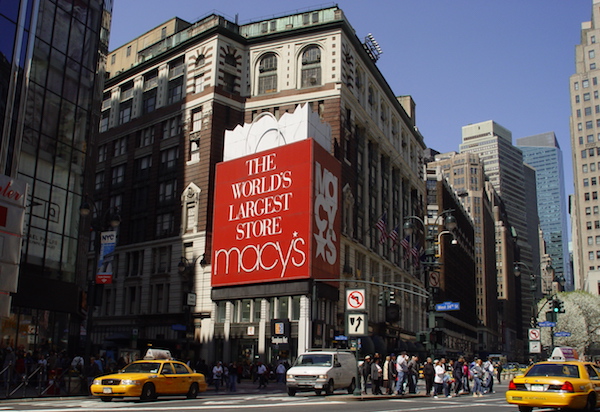
For more information on how retailers are using mixed commerce solutions, check out our Mixed Commerce Glossary, which defines the terminology being used by businesses to describe the changes currently sweeping retail. For a rundown of the biggest developments in Virtual Reality and Augmented Reality from the past 12 months, check out our 2016 roundup, Augmented Reality and Virtual Reality – The Year In Review. And for a look ahead, check out the 5 top Virtual Reality and Augmented Reality technology trends for 2017.
Venerable retailers like Macy’s are hoping mixed commerce can combat sinking sales …
There’s a sea change underway at America’s retailers. Macy’s has announced that it will be closing 100 stores in the next year, on top of the 40 it announced it would close last year — and the department store giant is not alone. According to a recent report by CNBC, Gap, Pier 1 Imports, Kohl’s and Office Depot have all been shuttering locations. Macy’s CEO Terry Lundgren appeared on CNBC’s Squawk Box in early August to explain the reasons for the company’s retail woes.
“Here’s the facts: In the United States, there’s 7.3 square feet per human being of retail space. That’s just ridiculous when you consider that in the UK it’s 1.3, in France it’s 1.7, in Japan it’s 1.7,” Lundgren told the hosts. “We have five and a half times the number of retail physical locations in America per capita than anywhere else in the world.”
Macy’s and other large retailers are struggling with this glut of retail square footage because anchor stores are no longer a draw. Consumers have proven they are willing to pay a premium for convenience, a fact that is rendering department and big box stores with aisles full of merchandise obsolete. Between online and mobile shopping, and the easy availability of retailers with smaller and more efficient footprints, large format retail and department stores have outgrown their former usefulness.
Enter “mixed commerce,” a new retail format where physical merchandise is replaced by 3D models that can be configured into scenes or viewed and interacted with on their own. Actual retail space is utilized to provide tactile engagement, allowing customers to actually interact with physical materials, along with mobile design tools. This new model blends the best of brick and mortar with leading edge digital technologies to create a high speed and ultra efficient sales process.
Fortune 1000 retailers and sales organizations are jumping into mixed commerce, and are actively exploring the use of Augmented Reality and Virtual Reality. They’re experimenting with online or mobile direct sales. They’re using iPad or Google Tango apps to build buyer confidence and provide better and more portable 3D configuration and quoting tools for field sales. In existing retail stores, they’re using technology as a kind of interactive point of purchase display that allows for configuration or an enhanced showroom and design experience — the Lowe’s Holoroom, for example.
At Marxent, we talk to businesses every day that are trying to leverage mixed commerce to get the most out of their physical locations, while also transitioning into a world where retail footprints will shrink even as revenue grows. In the past, retailers would look at adding features to a location — figuring out the best way to cram a Starbucks into a Target. But in the current retail climate, this equation has flipped. Smart retailers are asking themselves: How do you fit a Target into a Starbucks?
The mixed commerce model can take the shape of a pop-up store as small as 200 square feet, a Main Street or strip retail storefront as small as 1000 square feet, or an interactive 3D display. This smaller footprint alleviates the real estate price crunch, and means a business can set up shop in a non-traditional location — think airports, restaurants, malls, and other high-traffic areas.
There are already innovative companies using cutting edge technology and a new approach to pave a path toward the future of retail. Here’s three examples:
#1. Tesla will sell you a car at the mall
Tesla, the famed electric car company (that may really be a fancy battery company in disguise), has upended convention every step of the way. From abandoning the high-pollution internal combustion engine, to building out its own chain of refueling depots, Tesla is always looking for ways to do things different and better than they have been done before.
Perhaps the company’s biggest innovation is the abandoning of the traditional dealership model of car sales. Physical dealerships are a financial drain for the companies that own them. Between the expansive real estate, the cost of babysitting large numbers of unsold cars, and the significant staff necessary to run the business, it’s a wonder that dealerships have been so successful over such a long period of time.
Tesla cuts down on overhead by keeping its dealerships small (the Atlanta store featured in the above video is little more than 2000 square feet), and centrally locating its inventory, which is customized via computer by the buyer and then shipped to the customer after a purchase is made. It’s a business model that has run afoul of laws set up to protect car dealerships, but efficiency usually prevails in these types of battles, and we wouldn’t bet against Elon Musk anytime soon.
Other automakers are playing with other mixed commerce solutions to cut down on dealership space — including everything from Virtual Reality test drives to an entire VR showroom.
#2. Made.com mixes a physical showroom with virtual shopping
One common complaint from retailers is that there are some items people simply will not buy sight-unseen — largely because the item is expensive, or the buyer needs to see/touch/try it on before they will pull out a credit card. Trendy European furniture dealer Made.com is confronting this limitation head on, and has developed a retail concept that combines the best aspects of physical and online shopping.
Made.com maintains a physical showroom, though it is comparatively small compared to other furniture retailers. Shoppers check out the limited stock on hand, then use one of the store’s iMac computers to customize their selections and place an order.
Ning Li, co-founder and CEO, talked about the concept with retail-innovation.com, saying “Everyone is trying to find a way to link both online and physical worlds. Online, there are no square footage constraints – space is endless – so coming up with ways to showcase our full catalogue here was a challenge. We’ve achieved this by incorporating digital elements but only in ways we feel add value and are not in any way gimmicky.” So is this the end of the showroom? “Our showrooms continue to be a testing ground for new products; we use the space as an engagement tool with customers. It’s not about the hard-sell,” Ning Li said.
#3. Walking in a Target Wonderland
Target is one company that stands to lose big in our small-footprint future. The retailer has almost 2,000 stores across the U.S., and many more around the world. Fortunately, Target isn’t above trying new things, and a holiday concept it tried out last year may point the way to a future where entertainment and shopping merge into a singular activity.
During the 2015 holiday season, the retailer set up something called “Target Wonderland,” a free attraction in Manhattan’s Meatpacking district. The show featured what Target called, “10 larger-than-life spectacles, including a jumbo Etch-a-Sketch, a Christmas tree made from 320 green foam Hulk Hands, the S.S. Free Shipping LEGO pirate ship seen in Target’s holiday commercials and so. much. more.” Guests were given a custom lanyard with an RFID chip, which could then be used to scan bullseye-logo tags located throughout the event. At the end of their experience, the guests could review the shopping list and purchase whatever items they wanted.
With today’s shoppers looking for experiences instead of stuff, the Target Wonderland concept may be a way for retailers to appeal to Millennials — who are gaining more buying power every day — a one-of-a-kind day out that far outshines any traditional shopping outing. And in the future, that may be the difference between a banner year and bankruptcy.












